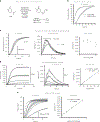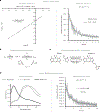Mechanistic and structural characterization of an iridium-containing cytochrome reveals kinetically relevant cofactor dynamics
- PMID: 40787229
- PMCID: PMC12333895
- DOI: 10.1038/s41929-022-00899-9
Mechanistic and structural characterization of an iridium-containing cytochrome reveals kinetically relevant cofactor dynamics
Abstract
Artificial metalloenzymes (ArMs), which contain non-native, typically synthetic, metal cofactors, are a flourishing class of biocatalyst for unnatural reactions. Although the number of these reactions is rapidly increasing, multi-faceted mechanistic studies of ArMs comprising structural, kinetic, computational and cofactor binding data to reveal detailed mechanistic information on the effects of the protein scaffold on the structure and reactivity of ArMs are more limited. Here we report the structure of an unnatural P450 analogue using X-ray diffraction. We also report the kinetic analysis of its reaction, catalyst activation during an induction period, and the origins of the stereoselectivity for the cyclopropanation of a terpene catalysed by the iridium-containing P450 variant (Ir(Me)-CYP119). Our data reveal a mechanism initiated by the flip of the cofactor from an inactive to an active conformation. This change in conformation is followed by thousands of turnovers occurring by rate-determining formation of an iridium-carbene intermediate, thereby highlighting the influence of cofactor dynamics within a single active site on an ArM-catalysed reaction.
Conflict of interest statement
Competing interests The authors declare no competing interests.
Figures







Similar articles
-
Short-Term Memory Impairment.2024 Jun 8. In: StatPearls [Internet]. Treasure Island (FL): StatPearls Publishing; 2025 Jan–. 2024 Jun 8. In: StatPearls [Internet]. Treasure Island (FL): StatPearls Publishing; 2025 Jan–. PMID: 31424720 Free Books & Documents.
-
Comparison of Two Modern Survival Prediction Tools, SORG-MLA and METSSS, in Patients With Symptomatic Long-bone Metastases Who Underwent Local Treatment With Surgery Followed by Radiotherapy and With Radiotherapy Alone.Clin Orthop Relat Res. 2024 Dec 1;482(12):2193-2208. doi: 10.1097/CORR.0000000000003185. Epub 2024 Jul 23. Clin Orthop Relat Res. 2024. PMID: 39051924
-
Systemic pharmacological treatments for chronic plaque psoriasis: a network meta-analysis.Cochrane Database Syst Rev. 2021 Apr 19;4(4):CD011535. doi: 10.1002/14651858.CD011535.pub4. Cochrane Database Syst Rev. 2021. Update in: Cochrane Database Syst Rev. 2022 May 23;5:CD011535. doi: 10.1002/14651858.CD011535.pub5. PMID: 33871055 Free PMC article. Updated.
-
Sexual Harassment and Prevention Training.2024 Mar 29. In: StatPearls [Internet]. Treasure Island (FL): StatPearls Publishing; 2025 Jan–. 2024 Mar 29. In: StatPearls [Internet]. Treasure Island (FL): StatPearls Publishing; 2025 Jan–. PMID: 36508513 Free Books & Documents.
-
Systemic pharmacological treatments for chronic plaque psoriasis: a network meta-analysis.Cochrane Database Syst Rev. 2020 Jan 9;1(1):CD011535. doi: 10.1002/14651858.CD011535.pub3. Cochrane Database Syst Rev. 2020. Update in: Cochrane Database Syst Rev. 2021 Apr 19;4:CD011535. doi: 10.1002/14651858.CD011535.pub4. PMID: 31917873 Free PMC article. Updated.
Cited by
-
Enantioselective Synthesis of Spirocyclic Nitrogen-Containing Heterocycles Catalyzed by an Iridium-Containing Cytochrome.J Am Chem Soc. 2025 Aug 13;147(32):28875-28881. doi: 10.1021/jacs.5c06239. Epub 2025 Aug 1. J Am Chem Soc. 2025. PMID: 40749167 Free PMC article.
References
Grants and funding
LinkOut - more resources
Full Text Sources
